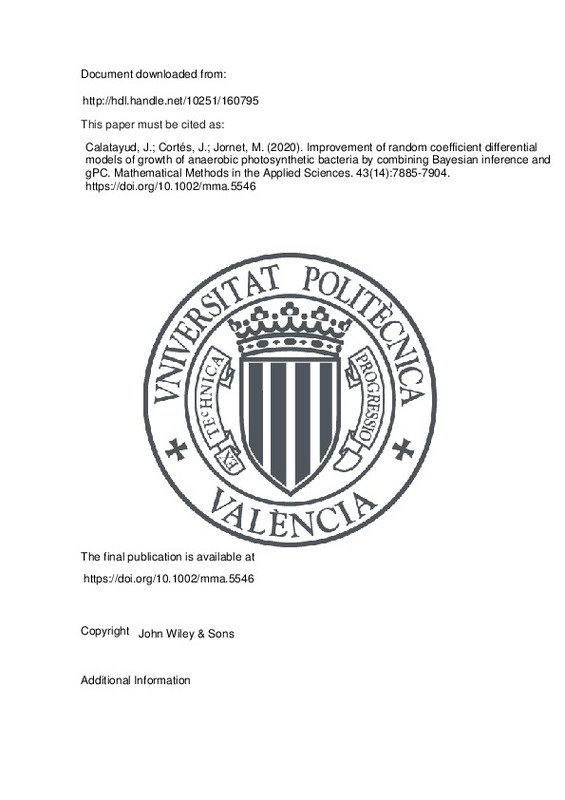Monod, J. (1949). THE GROWTH OF BACTERIAL CULTURES. Annual Review of Microbiology, 3(1), 371-394. doi:10.1146/annurev.mi.03.100149.002103
Novick, A. (1955). Growth of Bacteria. Annual Review of Microbiology, 9(1), 97-110. doi:10.1146/annurev.mi.09.100155.000525
Dutta, R. (2008). Fundamentals of Biochemical Engineering. doi:10.1007/978-3-540-77901-8
[+]
Monod, J. (1949). THE GROWTH OF BACTERIAL CULTURES. Annual Review of Microbiology, 3(1), 371-394. doi:10.1146/annurev.mi.03.100149.002103
Novick, A. (1955). Growth of Bacteria. Annual Review of Microbiology, 9(1), 97-110. doi:10.1146/annurev.mi.09.100155.000525
Dutta, R. (2008). Fundamentals of Biochemical Engineering. doi:10.1007/978-3-540-77901-8
Hethcote, H. W. (2000). The Mathematics of Infectious Diseases. SIAM Review, 42(4), 599-653. doi:10.1137/s0036144500371907
Murray, J. D. (Ed.). (2002). Mathematical Biology. Interdisciplinary Applied Mathematics. doi:10.1007/b98868
Zwietering, M. H., Jongenburger, I., Rombouts, F. M., & van ’t Riet, K. (1990). Modeling of the Bacterial Growth Curve. Applied and Environmental Microbiology, 56(6), 1875-1881. doi:10.1128/aem.56.6.1875-1881.1990
McKellar, R. C. (2001). Development of a dynamic continuous-discrete-continuous model describing the lag phase of individual bacterial cells. Journal of Applied Microbiology, 90(3), 407-413. doi:10.1046/j.1365-2672.2001.01258.x
FUJIKAWA, H., KAI, A., & MOROZUMI, S. (2003). A New Logistic Model for Bacterial Growth. Journal of the Food Hygienic Society of Japan (Shokuhin Eiseigaku Zasshi), 44(3), 155-160. doi:10.3358/shokueishi.44.155
Juška, A., Gedminienė, G., & Ivanec, R. (2006). Growth of microbial populations. Mathematical modeling, laboratory exercises, and model-based data analysis. Biochemistry and Molecular Biology Education, 34(6), 417-422. doi:10.1002/bmb.2006.494034062669
Strand, J. . (1970). Random ordinary differential equations. Journal of Differential Equations, 7(3), 538-553. doi:10.1016/0022-0396(70)90100-2
Øksendal, B. (2003). Stochastic Differential Equations. Universitext. doi:10.1007/978-3-642-14394-6
Dorini, F. A., Cecconello, M. S., & Dorini, L. B. (2016). On the logistic equation subject to uncertainties in the environmental carrying capacity and initial population density. Communications in Nonlinear Science and Numerical Simulation, 33, 160-173. doi:10.1016/j.cnsns.2015.09.009
Dorini, F. A., & Cunha, M. C. C. (2008). Statistical moments of the random linear transport equation. Journal of Computational Physics, 227(19), 8541-8550. doi:10.1016/j.jcp.2008.06.002
Casabán, M.-C., Cortés, J.-C., Romero, J.-V., & Roselló, M.-D. (2015). Probabilistic solution of random SI-type epidemiological models using the Random Variable Transformation technique. Communications in Nonlinear Science and Numerical Simulation, 24(1-3), 86-97. doi:10.1016/j.cnsns.2014.12.016
Calatayud, J., Cortés, J.-C., & Jornet, M. (2018). The damped pendulum random differential equation: A comprehensive stochastic analysis via the computation of the probability density function. Physica A: Statistical Mechanics and its Applications, 512, 261-279. doi:10.1016/j.physa.2018.08.024
Calatayud, J., Cortés, J. C., & Jornet, M. (2018). Uncertainty quantification for random parabolic equations with nonhomogeneous boundary conditions on a bounded domain via the approximation of the probability density function. Mathematical Methods in the Applied Sciences, 42(17), 5649-5667. doi:10.1002/mma.5333
Xiu, D. (2010). Numerical Methods for Stochastic Computations. doi:10.2307/j.ctv7h0skv
Chen-Charpentier, B.-M., Cortés, J.-C., Licea, J.-A., Romero, J.-V., Roselló, M.-D., Santonja, F.-J., & Villanueva, R.-J. (2015). Constructing adaptive generalized polynomial chaos method to measure the uncertainty in continuous models: A computational approach. Mathematics and Computers in Simulation, 109, 113-129. doi:10.1016/j.matcom.2014.09.002
Cortés, J.-C., Romero, J.-V., Roselló, M.-D., & Villanueva, R.-J. (2017). Improving adaptive generalized polynomial chaos method to solve nonlinear random differential equations by the random variable transformation technique. Communications in Nonlinear Science and Numerical Simulation, 50, 1-15. doi:10.1016/j.cnsns.2017.02.011
Stanescu, D., & Chen-Charpentier, B. M. (2009). Random coefficient differential equation models for bacterial growth. Mathematical and Computer Modelling, 50(5-6), 885-895. doi:10.1016/j.mcm.2009.05.017
Calatayud, J., Cortés, J. C., Jornet, M., & Villanueva, R. J. (2018). Computational uncertainty quantification for random time-discrete epidemiological models using adaptive gPC. Mathematical Methods in the Applied Sciences, 41(18), 9618-9627. doi:10.1002/mma.5315
Calatayud, J., Cortés, J.-C., & Jornet, M. (2018). On the convergence of adaptive gPC for non-linear random difference equations: Theoretical analysis and some practical recommendations. Journal of Nonlinear Sciences and Applications, 11(09), 1077-1084. doi:10.22436/jnsa.011.09.06
Lesaffre, E., & Lawson, A. B. (2012). Bayesian Biostatistics. doi:10.1002/9781119942412
Mohammad-Djafari, A. (2002). Bayesian inference for inverse problems. AIP Conference Proceedings. doi:10.1063/1.1477067
Corberán-Vallet, A., Santonja, F. J., Jornet-Sanz, M., & Villanueva, R.-J. (2018). Modeling Chickenpox Dynamics with a Discrete Time Bayesian Stochastic Compartmental Model. Complexity, 2018, 1-9. doi:10.1155/2018/3060368
Marzouk, Y. M., Najm, H. N., & Rahn, L. A. (2007). Stochastic spectral methods for efficient Bayesian solution of inverse problems. Journal of Computational Physics, 224(2), 560-586. doi:10.1016/j.jcp.2006.10.010
Marzouk, Y., & Xiu, D. (2009). A Stochastic Collocation Approach to Bayesian Inference in Inverse Problems. Communications in Computational Physics, 6(4), 826-847. doi:10.4208/cicp.2009.v6.p826
Turchin, P. (2001). Does population ecology have general laws? Oikos, 94(1), 17-26. doi:10.1034/j.1600-0706.2001.11310.x
RoosAM.Modeling Population Dynamics Netherlands: Notes from the University of Amsterdam;2014.
Casella, G. (1985). An Introduction to Empirical Bayes Data Analysis. The American Statistician, 39(2), 83. doi:10.2307/2682801
Lunn, D. J., Thomas, A., Best, N., & Spiegelhalter, D. (2000). Statistics and Computing, 10(4), 325-337. doi:10.1023/a:1008929526011
Depaoli, S., Clifton, J. P., & Cobb, P. R. (2016). Just Another Gibbs Sampler (JAGS). Journal of Educational and Behavioral Statistics, 41(6), 628-649. doi:10.3102/1076998616664876
Johnson, T. R., & Kuhn, K. M. (2013). Bayesian Thurstonian models for ranking data using JAGS. Behavior Research Methods, 45(3), 857-872. doi:10.3758/s13428-012-0300-3
StokesM ChenF GunesF.An introduction to Bayesian analysis with SAS/STATR software Proceedings of the SAS Global Forum 2014 Conference SAS Institute Inc Cary USA(available athttps://support.sas.com/resources/papers/proceedings14/SAS400‐2014.pdf). Citeseer; 2014.
Giraud, L., Langou, J., & Rozloznik, M. (2005). The loss of orthogonality in the Gram-Schmidt orthogonalization process. Computers & Mathematics with Applications, 50(7), 1069-1075. doi:10.1016/j.camwa.2005.08.009
Ernst, O. G., Mugler, A., Starkloff, H.-J., & Ullmann, E. (2011). On the convergence of generalized polynomial chaos expansions. ESAIM: Mathematical Modelling and Numerical Analysis, 46(2), 317-339. doi:10.1051/m2an/2011045
Shi, W., & Zhang, C. (2012). Error analysis of generalized polynomial chaos for nonlinear random ordinary differential equations. Applied Numerical Mathematics, 62(12), 1954-1964. doi:10.1016/j.apnum.2012.08.007
Pukelsheim, F. (1994). The Three Sigma Rule. The American Statistician, 48(2), 88. doi:10.2307/2684253
[-]







![[Cerrado]](/themes/UPV/images/candado.png)


